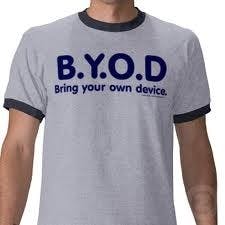Bring your own device (or BYOD) is all the rage.
Device policy and administration is beyond my pay grade. For that, you can talk to Steve Boese.
What I can tell you is that there are a couple schools of thought when it comes to thinking about employee wants and technology from the HR perspective:
- Screw these guys. We pay them good money, they get to heft around an 8 pound ThinkPad and a locked down Blackberry.
- Screw these guys. We don’t pay them good money but they are still our employees and have to do what we say. Drop that three year old tech on them!
- BYOD stands for buy your own device, right? It can’t cost more to administer these different devices than it does to purchase them.
- We should subsidize their purchase? Hell, for that why don’t we just buy them what they want (within a certain group of choices) and retain ownership of it?
- We bought brand new computers in 2009! We don’t have them budgeted for replacement until 2014.
Increasing performance and satisfaction
This conversation drives me crazy. This is the raging debate about bringing your own device to work?
 How about this: why don’t you pick the policy that actually increases the performance and satisfaction of technology users in your organization?
How about this: why don’t you pick the policy that actually increases the performance and satisfaction of technology users in your organization?
Maybe this seems like a common sense thing to you. I hope it does. But too often, HR (and management, or finance, or whoever you want to assign blame to) break it down to a straight cost discussion or a political power discussion. This is dumb and I’ve dealt with it in the past, too.
For example, we had well-paid developers doing programming on single 19? CRT monitors (those big, boxy, tube monitors) when 22? LCD panels were available for under $500 a pop. Why? Because buying new monitors was too expensive.
Ignore the stuff out there about huge productivity gains with multiple monitors. Or, take it with a grain of salt. The fact is, you don’t need huge productivity gains (or losses) to gain back an ROI.
A very modest increase in productivity (we figured in our calculations to be about 5 percent, studies said that it could be much more) meant we were getting a return on our LCD purchases within a couple of months. Over the life of a decent LCD panel, it would pay itself off 12-fold in productivity gains. The same could be true of any device you purchase or subsidize so that the employee can be as productive as possible.
Considering more than just cost
Even if it isn’t about performance, shouldn’t employee satisfaction also be a consideration? I’m not saying you have to change to a BYOD policy or a corporate owned, personally enabled (COPE) policy either. Some employees are just going to dig the equipment you provide and mandate they use (and sometimes, that equipment does kick ass).
Some of them won’t care. But if it does matter and it does impact performance or satisfaction, isn’t it worth a more thoughtful consideration than disregarding out of hand an additional cost that is likely a pretty small fraction of the total cost of employment?
I don’t really care what you choose in the end. At all. But if you haven’t thought through more than just raw costs on it, I would urge you to consider all of the factors in play here.
What’s your policy on devices? Do you do BYOD or COPE? Is your CIO the tech overlord?
The was originally published at Lance Haun’s (Life Between the Brackets) blog.
